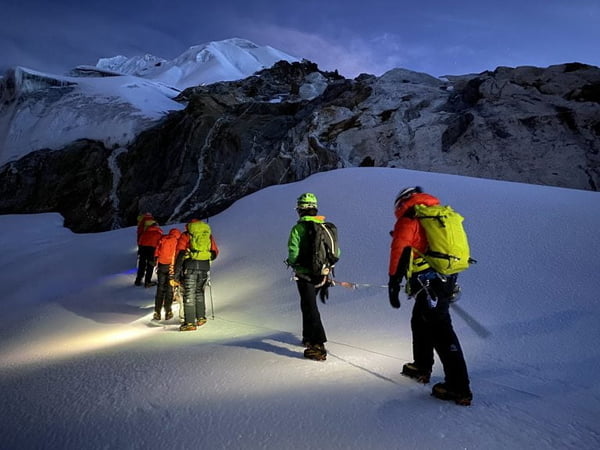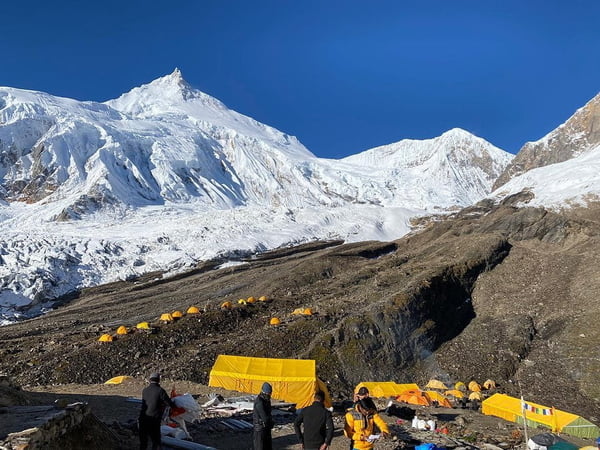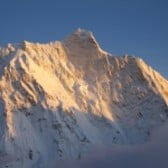
Daily Mountain
48 years, Australia
First Summit of 2020 in Nepal, Death and Rescue in Pakistan
This article first appeared on http://explorersweb.com. The original can be read here.
Bahrain’s Royal Prince Sheik Nasser bin Hamad Al Khalifa will have a positive reason to remember 2020. Last Saturday, he and his Royal Guard team enjoyed the first summit view of Nepal’s Himalaya this year, from the top of Lobuche Peak on a clear, sunny morning.
Mingma Sherpa and Seven Summit Treks CEO Tashi Lakpa, together with 25 Sherpas, supported the approximately dozen climbers. Beautiful weather and good hard snow made the climb idyllic.
 Lobuche climbers set out on a beautiful night, barely scratching the hard snow with their crampons. Photo: Seven Summit Treks
Lobuche climbers set out on a beautiful night, barely scratching the hard snow with their crampons. Photo: Seven Summit Treks
This year started with three expeditions attempting winter Everest, without success. Then COVID-19 closed down the country until September 17, when it reopened with severe restrictions. The well-connected Bahraini team became the first (and so far, the only) foreign group allowed to climb in Nepal’s Himalaya. In exchange, they enjoyed the rare privilege of having the entire Khumbu Valley to themselves.
The climbers are back in Kathmandu for some rest and recovery. Later this week, they’ll move on to their ultimate goal: Manaslu. Here, a second STT team, led by Dawa Sherpa and record Everest summiter Kami Rita Sherpa, has been in place since last week, fixing the route and high camps.
 On Manaslu, Sherpas fix the route and set high camps for the Bahraini expedition. Photo: STT
On Manaslu, Sherpas fix the route and set high camps for the Bahraini expedition. Photo: STT
The heavily supported expedition will not impress alpine-style purists, but the Bahrainis are helping Nepal’s shattered tourism industry by employing such a large crew.
Meanwhile, the mountains of Pakistan have attracted quite the opposite kind of teams: small groups or climbing pairs, looking for exploratory trips and new routes on smaller peaks. Pakistan opened to foreigners in mid-summer, too late for larger teams to plan complex expeditions to the 8,000’ers, but allowing seasoned climbers to venture into wilder corners on light, alpine-style ascents.
Some teams are already home, either with new ascents under their belt, like Felix Berg’s SummitClimb team in the Shimshal Valley, or at least with adventurous attempts on rarely visited peaks, such as the Czech and German/Spanish pairs currently on Muchu Chhish or Saad Mohamed on Rakhiot Peak. Mohamed has just posted a video of their expedition, below.
Colin Haley is also on his way home, with a less positive experience. Although he dodged COVID-19, he was hit with a much more traditional ailment in that part of the world: an intestinal bug that gave him the severe trots just as he was at 5,200m, poised to climb K6. “A week of high-altitude diarrhea had left me unfit,” he wrote from Skardu. “While K6 West seemed like a decent [alternative after he’d recovered], I felt like October was getting too cold for a 7,000m peak in the Karakorum.”
Meanwhile, a Polish climbing pair’s expedition to Dhi Sar in the Shimshal ended tragically when Jakob Michal Ilczuk fell to his death from about 5,800m. Details on the accident are sketchy, but his partner, Jakob Bodganski, managed to descend and called for help by satphone. A seven-member rescue patrol, led by K2 summiter Shaheen Baig, came but was unable to reach IIczuk’s body. The injured Bodganski was airlifted to Gilgit.
Finally, another team has begun preparing to attempt Winter K2 a year from now. Veteran Everest guide Alex Abramov will lead the mainly Russian team, with Vladimir Suviga as deputy leader. Their training plan includes Elbrus this winter and then K2 under summer conditions in July 2021. A few months later, they will return to K2 for the prestigious winter attempt, which so many of the world’s best high-altitude climbers dream of nailing first.





